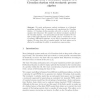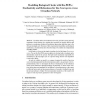76 search results - page 1 / 16 » Stochastic Process Algebra Models of a Circadian Clock |
DAGSTUHL
2006
13 years 6 months ago
2006
We present stochastic process algebra models of a Circadian clock mechanism used in many biological organisms to regulate time-based behaviour. We compare modelling techniques fro...
EPEW
2008
Springer
13 years 6 months ago
2008
Springer
We apply performance analysis techniques to a biological modelling problem, that of capturing and reproducing the Circadian rhythm. A Circadian rhythm provides cells with a clock b...
CMSB
2009
Springer
13 years 11 months ago
2009
Springer
Circadian clocks are biochemical networks, present in nearly all living organisms, whose function is to regulate the expression of specific mRNAs and proteins to synchronise rhyth...
CDC
2010
IEEE
12 years 11 months ago
2010
IEEE
Circadian rhythms are biological processes found in all living organisms, from plants to insects to mammals that repeat with a period close to, but not exactly, 24 hours. In the ab...
MCM
2011
12 years 11 months ago
2011
Molecular circadian clocks, that are found in all nucleated cells of mammals, are known to dictate rhythms of approximately 24 hours (circa diem) to many physiological processes. ...


